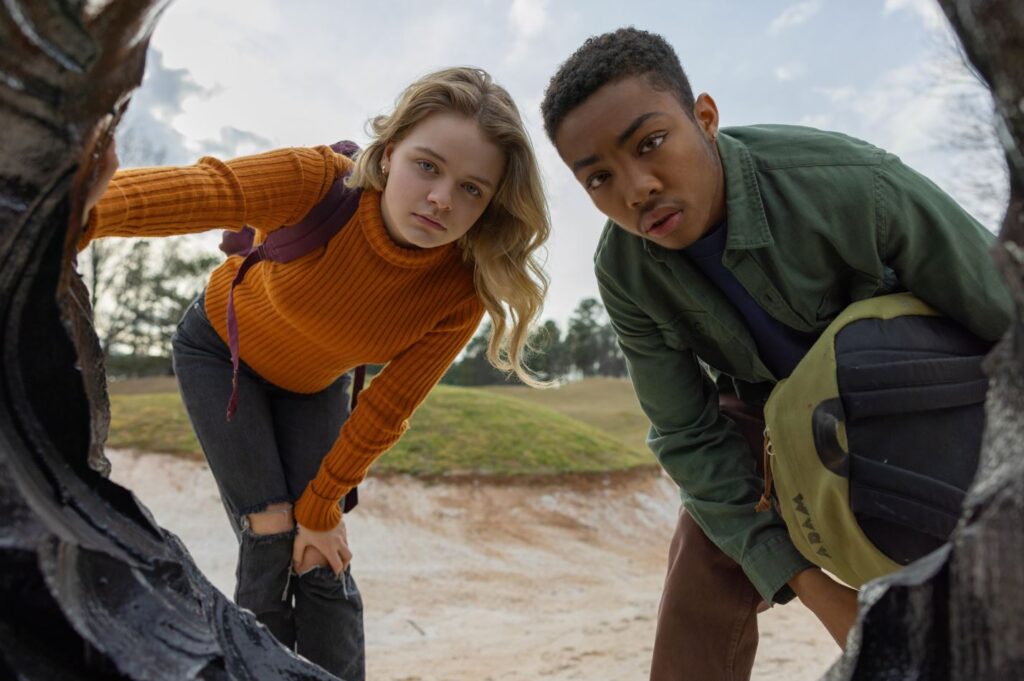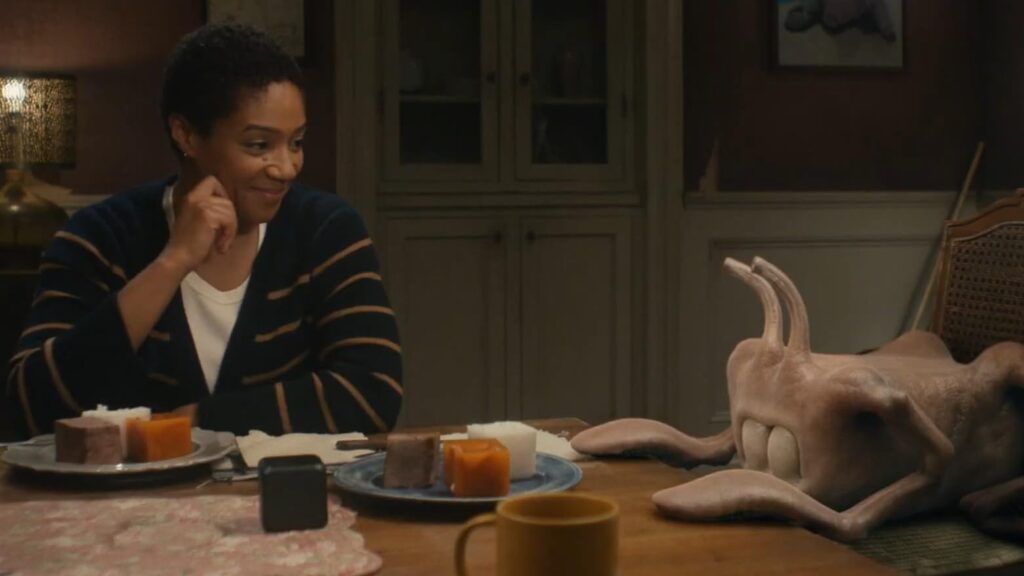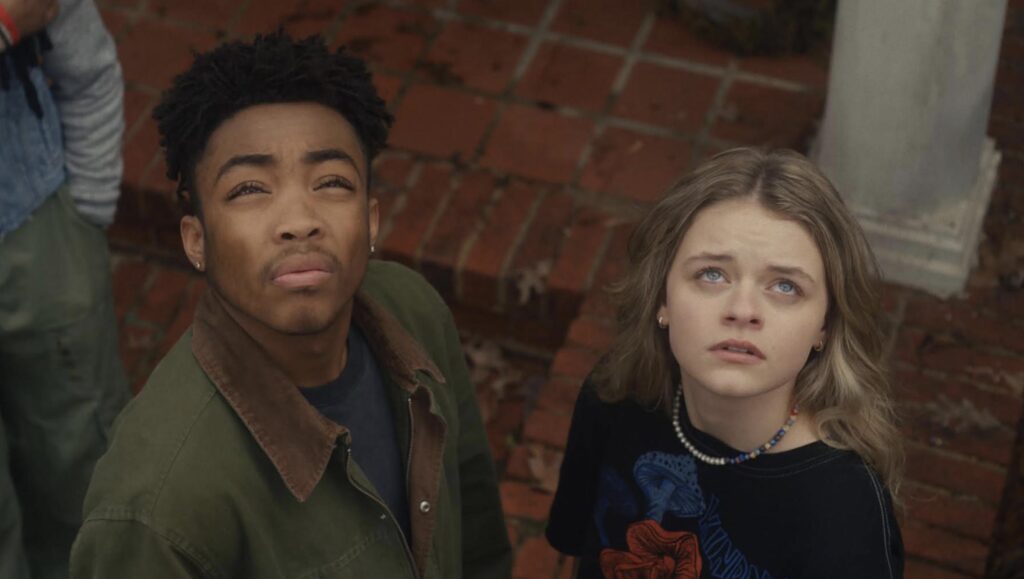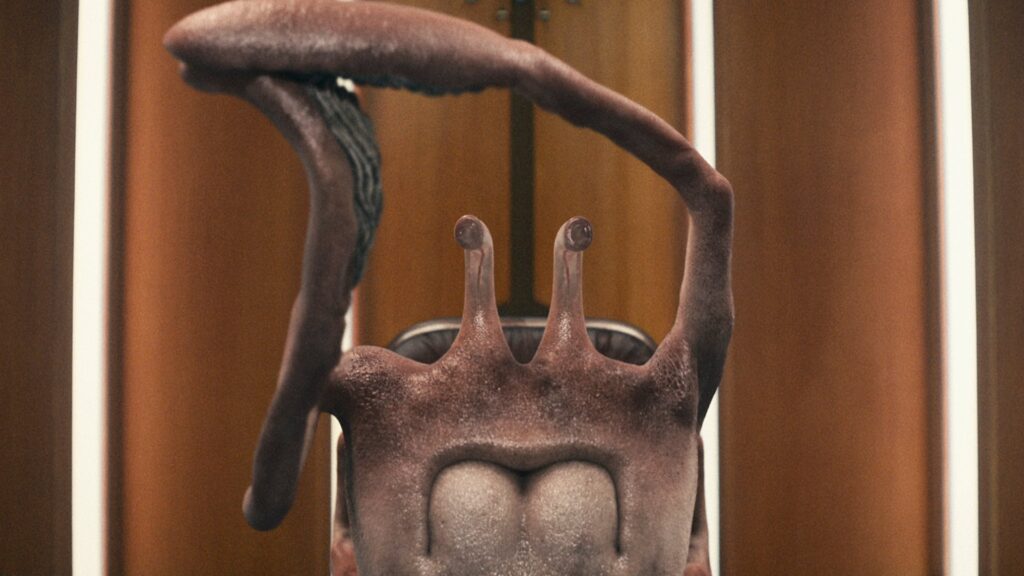
Cory Finley won’t repeat himself. You couldn’t have blamed him, following his electrifying debut of Thoroughbreds, if he’d chosen to keep making razor-sharp thrillers his whole career. Instead he pivoted to docudrama with Bad Education, telling the fact-based story of a different sort of sociopath who preyed on people not with poison and knives but with smiles and scams. His new movie, Landscape with Invisible Hand, is also partially set in the classroom, but the malfeasance it chronicles is far stranger than garden-variety embezzlement. Early on, an English teacher informs his students that his “microscopic salary” has nevertheless been deemed too onerous for the new administration. He then strolls into the courtyard and, with minimal fanfare, puts a gun in his mouth and splatters his brains all over the concrete. Bad education, indeed.
It’s a jolting introduction, one which signals that the ensuing picture won’t conform to the sanitized standards of the young-adult playbook. But the oddness of Landscape with Invisible Hand is apparent even earlier. Its very first scene finds a young aspiring painter named Adam Campbell (Asante Blackk, from This Is Us) sketching a vista of the bright blue sky, only for his view to become clouded when a gigantic flying saucer rolls overhead. That might seem alarming, but Adam reacts with resigned annoyance—“Find someplace else to park!”—and we immediately realize that we’re watching a piece of dystopian fiction. But where many alien-invasion films traffic in terror and violence, this one is characterized by drudgery and disenchantment.

Based on a novel by M.T. Anderson (which I haven’t read), Finley’s screenplay begins in medias res. The extraterrestrials, a race of squishy snail-like creatures called the Vuvv (one character describes them as “gooey coffee tables”), have already infiltrated Earth, though they might describe their arrival as an intervention. As a propagandistic orientation video explains to Adam’s class (and to us), the Vuvv believe in diplomacy rather than aggression, wielding their superior technology to serve as humanity’s benefactors and stave off ecological calamity. Yet despite their noble intentions, their colonization has yielded harsh consequences, both socially and economically; education now takes place on “nodes” which students attach to their temples (creating a virtual-reality environment), while the job market for skilled laborers has receded in light of the aliens’ supremacy.
This is a lot to take in, but Finley conveys the necessary information with efficiency and without embellishment. (No expository voiceovers here.) He packs detail into his smartly composed frames, as in a brief shot of a cafeteria menu that includes weirdly hybridized foodstuffs like “wheatmeal loaf” and “cryptid crackers.” But he is less concerned with tallying the eccentricities of this unsettling new society than with exploring its psychological impact on his characters.

The Campbells—in addition to Adam, they include his mother, Beth (Tiffany Haddish), and his younger sister, Natalie (Brooklynn MacKinzie)—occupy what seems to be a vanishing middle class; they still own their house, but Beth’s career as a lawyer has been rendered obsolete, while her husband has long since absconded in search of greener pastures. They’re struggling, but not as badly as the Marshes, an itinerant trio who have joined the mass of evictees wandering the streets of the movie’s unspecified, allegorical neighborhood. (Shooting took place in Atlanta.) The youngest Marsh, Chloe (Kylie Rogers, from Beau Is Afraid), is a looker in Adam’s class, and he instantly develops a crush on her, prompting him to invite her entire family—she has a prideful father (Josh Hamilton) and a surly older brother (Michael Gandolfini)—to stay in his basement, a selfless gesture that quickly provokes tensions and resentments.
The first and most enjoyable stretch of Landscape with Invisible Hand centers on Adam and Chloe’s nascent romance, a recognizable freefall of young love that doubles as a commercial venture. The Vuvv reproduce asexually, and their anthropological curiosity about human attraction has created a lucrative market for real-time dating broadcasts. The result is something like a cross between The Lobster and a self-aware Truman Show; flicking on their nodes and narrating their exploits for the benefit of a ravenous audience, Adam and Chloe warp their ostensibly private moments into public entertainment. Their tender intimacy becomes a product of universal availability.

It’s easy to envision Landscape with Invisible Hand proceeding exclusively along this trajectory, with its two teens cementing their affection while dodging the logistical and existential obstacles presented by their unusual predicament. That probably would have been satisfying, but satisfaction is not among Finley’s chief objectives. He is after something more complicated and ambitious, using the familiar building blocks of youth-oriented science-fiction as a scaffold to meditate on a variety of mature themes—the complexity of marriage, the value of sex in relationships, the tradeoff between professional success and personal fulfillment, even the social utility of art itself.
This is audacious terrain, and the movie doesn’t always navigate it smoothly. One consequence of Finley’s sprawling approach is that it can disrupt his fluid rhythms, with narrative pivots that lurch rather than glide. He also allows a layer of judgment to seep into his characterizations; he is a bit too easy on the Campbells and a bit too hard on the Marshes, treating the latter as the butt of easy jokes and flattening their personalities in the process. It’s fitting that the Vuvv struggle to swallow large pieces of food, given that Finley has arguably bitten off more than he can chew.

But if some messiness is a necessary byproduct of his restless imagination, it’s a sacrifice I’ll happily accept. Visually, Landscape with Invisible Hand is accomplished without being boastful; the Vuvv, with their pallid pink skin and squirmy antennae, are convincingly rendered such that they’re suitably exotic and also kinda gross. (Their method of communication—slapping and rubbing their floppy appendages together, like they’re scraping sand from their skin—reinforces Finley’s gift for immersive sound design.) But it is primarily a work of ideas, deploying a broad array of concepts—the specter of debtor’s prison, the manufacture of globular rations in place of actual food, the function of gender roles in classic sitcoms—in pursuit of its central interrogation of the human spirit. As much as I liked Bad Education, I couldn’t help chafing against its relative normalcy. This film is different—bold, chaotic, provocative—which is why it’s precisely the kind of movie a director of Finley’s talent should be making.
At multiple points in Landscape with Invisible Hand, characters discuss “higher-order needs,” justifying their lack of commitment to secondary pleasures because they’re more concerned with basic survival. The beauty of this picture is that it acknowledges the validity of their feelings while also demolishing the distinction. It argues, with persuasive conviction, that we need more than just things to survive; we need love, community, and art (or as the Vuvv call it, “human art”). That’s why the movie’s most painful, poignant image is that of a building’s ruined façade, when it once housed a colorful mural—a vibrant protest that became just another desecrated commodity. Yet the wreckage that remains is also oddly uplifting. The Vuvv can plunder humanity’s resources, but they can’t take away our impulse to keep painting on the nearest wall.
Grade: B+
Jeremy Beck is the editor-in-chief of MovieManifesto. He watches more movies and television than he probably should.
